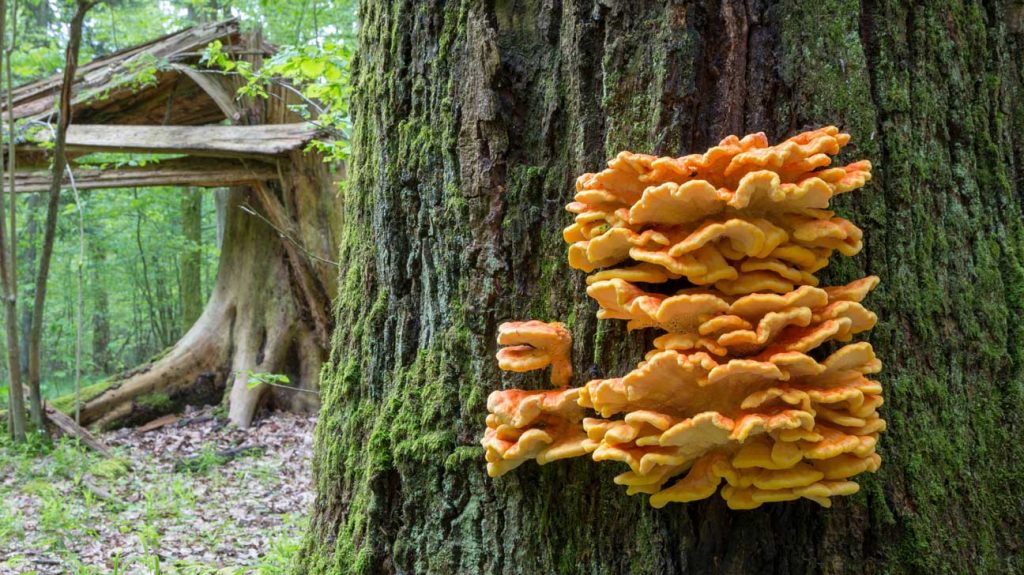If you go looking for wild mushrooms, you’ll find some Mushrooms that grow on Trees.
Mushrooms on trees are somewhat easier to spot than mushrooms on the ground, and many have strange and interesting shapes. Some are edible and some are not—and some are the subject of confusion or controversy. This article is not a guide on how to find your dinner; it’s a quick introduction to some of the more interesting species a beginner mushroom-fancier is likely to see while out walking in the woods.
Our title is a bit of a misnomer, by the way, in that most tree-loving fungi don’t grow on trees but in them. Fungi, like animals, must eat, and some eat wood, creeping silently and slowly through their dinner, mostly unseen, until eventually they send out fruiting bodies—mushrooms—into the open air.
Not all fungi produce mushrooms (some form crusts or have microscopic fruiting bodies), but those that do are many and varied.
Wood-loving fungi vary in their taste in food. Some prefer fresh wood, some prefer well-rotted wood. Some like to eat lignan, leaving the soft, white cellulose behind (white rot), while some like to eat cellulose, leaving the hard, brown, crumbly lignan behind (brown rot)[i]. Some fungi attack live trees and kill them, while others can nibble at live trees without killing them, and still others prefer their food already dead. All fungi that attack live trees specialize in just a few kinds of prey—live trees fight back, and fungi that develop ways to defeat the defenses of one kind of tree are not necessarily able to defeat the different defenses of other kinds.
There are many more tree-loving mushrooms than we could possibly list. Here is just a hint of what’s out there—these are widely-spread mushrooms or groups of mushrooms, so there is likely to be species on this list in your area.
We’re writing this article because we hope the next time you spot a fungus fruiting from a tree, you stop and take a look. Because mushrooms are awesome.
Mushrooms that Fruit from Living Trees
Many fungi can eat both living and dead wood, and some fruit from both living and dead wood. So while the following species are often found on live trees, you may find them elsewhere, too.
Reishi (Ganoderma sp.)

Reishi’s are very misunderstood mushrooms. Part of the problem is that what we used to think was a single, widespread species is actually several species that all look alike. The Asian species, G. lingzhi, has been used in folk medicine for a very long time, possibly thousands of years—while the fruiting body is too tough to eat, it can be made into tea. Reishi products have recently become very popular for medicinal use outside of Asia, too. Preliminary scientific research suggests at least some of these uses may be effective, while others might actually be toxic.
The possible toxicity is one problem hardly anybody ever talks about. The other problem is that while many people treat all the various reishi species as medicinally interchangeable, there is no reason to suppose they really are. It’s quite possible that some are medicinally useless or even dangerous. We don’t know, yet.
There are reishi species that grow wild in North America, usually fruiting from the trunks of their favorite trees (each species has its own favorites). The fruiting bodies are long-lasting, woody in texture, fan-shaped or spoon-shaped, and shiny as though lacquered.
Oyster (Pleurotus sp.)
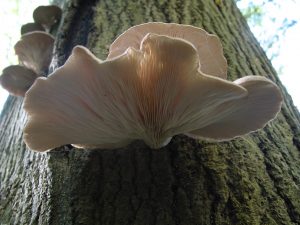
The oysters are a group of mushroom species so called because some of them vaguely resemble oysters—others don’t. The different species come in various shapes, sizes, and colors. They all like wood, many will fruit from the trunks of live trees, and all are edible. They have a soft, delicate texture and a subtle but lovely taste. Some oyster mushroom species are easy to cultivate, and you can buy grow-kits for them online. There is good, but still preliminary, evidence that at least some have medicinal properties.
Although all oyster mushrooms are edible, some species do have inedible look-alikes that could confuse a beginner.
Chicken-of-the-Woods (Laetiporus sp.)

Chicken mushrooms actually do taste like chicken, hence the name. They also have a very distinct appearance, growing in clusters of shelves in yellow, orange, or pink (hence their other name, sulfur shelf), and so many writers present them as ideal quarry for beginner foragers. Bad idea.
A relatively recent discovery is that there are actually multiple chicken-of-the-woods species, and while some are excellent eating, others are unpalatable or even mildly toxic. Experienced foragers can sort out the differences without too much trouble, but they are hardly the fool-proof wild edibles they are often made out to be.
Lion’s Mane and Friends (Hericium sp.)
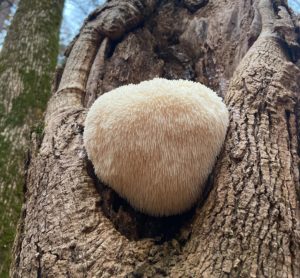
Lion’s mane is the best-known of a small group of mushrooms famous for being covered all over with soft, hair like spines. All are edible and taste rather like crab meat, and all are white or off-white. Lion’s mane itself looks rather like a tribble, for those familiar with Star Trek. The others branch and variously resemble clusters of pom-poms or certain undersea corals.
Lion’s mane may have medicinal value, according to preliminary research, but it’s unknown whether the other Hericiums do—that doesn’t stop many people from treating them all as medicinally interchangeable. Sigh.
Honey Mushroom (Armillaria sp.)
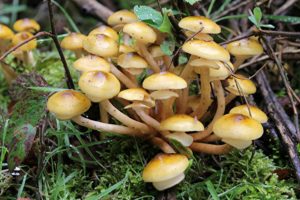
Honey mushrooms are so called, not for their flavor, but for their color—various shades of reddish or yellowish brown. At least some species are edible. Some foragers are moving away from the honeys, though, because they sometimes make people sick, and it’s not yet clear why. Also, honeys are basically nondescript little brown mushrooms, and as such very difficult to distinguish from other nondescript little brown mushroom species, some of which can kill you.
Honey mushroom’s other claim to fame is that there is an individual honey fungus that may be the largest living organism in the world. Since most of it is inside the trees it is busy eating (root-like structures connect the mycelium in each tree to make a single, huge network), you wouldn’t notice its size if you simply walked through its forest—but it is miles across.
Artists’ Conk (Ganoderma applanatum)
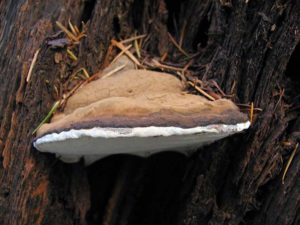
Not all Ganodermas are Reishi’s. This one is a shelf fungus that bears a kind of family resemblance to the Reishi’s, but lacks their distinctive shine. Artist’s conk is not edible. Its claim to fame is that its pore surface is such that if you scratch it or bruise it, you will leave dark marks on a cream-colored background. Artists harvest the large, woody fruiting bodies and use them to create lovely, intricate drawings.
Harvesting a mushroom doesn’t damage the mycelium beneath any more than picking an apple damages an apple tree, but it’s still important not to over-harvest, especially in this case, where the perennial fruiting body could have taken many years to grow.
Mushrooms that Fruit only from Dead Wood
There are also fungi that only fruit from dead wood, either because they only eat dead wood or because they don’t fruit until after the tree has died. Some fungi with persistent, woody fruiting bodies, the kind that last for years, will start fruiting when the tree is still standing. When the dead tree falls over, the fruiting bodies end up sideways. The fungus responds by either making new fruiting bodies oriented the right way or by growing the existing fruiting bodies into a new, twisted shape. It’s kind-of disturbing-looking.
Turkey-Tail (Trametes versicolor)
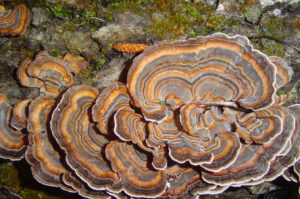
This fungus feeds on dead and rotting wood and produces clusters of fan-shaped fruiting bodies with the texture of dry card-stock. The name reflects the color pattern, which does in deed resemble that of the spread tail of a wild turkey, though the colors themselves vary wildly. The species has a number of look-alikes, and the name, Turkey Tail, is sometimes used to describe all of them in a somewhat dismissive way by mycophiles looking for something else (“oh, it’s just one a those turkey-tails”)[ii]. Spotting the real turkey-tail in the group is not difficult, though, for those in the know.
Turkey-tail is inedible and though it is reputed to have some medicinal value, but the real draw is that they are pretty—and the fruiting of turkey-tail is proof that the tree has been dead at least three years, a useful bit of information for those interested in the history of forests.
Witch’s Butter (Tremella mesenterica)
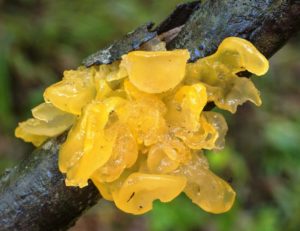
The name, witch’s butter, applies to multiple species with globby-blobby fruiting bodies, mostly in yellow or orange. Most can’t be distinguished from each other without a microscope, and most are reputed to be edible but more or less tasteless. Most people’s primary interest in this species is to say “oh, look, it’s witch’s butter; how very odd.”
This particular witch’s butter is notable for not actually eating wood. Instead it is parasitic on another fungus that eats wood—but you won’t likely see the other fungus, as it’s mostly inside the wood[iii].
Psilocybe sp.
Not all Psilocybes like wood. In fact, many species in the group eat dung or the roots of grasses. But there are wood-lovers among the Psilocybes, with varying degrees of psychoactive potency. They are often found fruiting from wood-mulch, and it’s not always clear what their favored food source was before humans started mulching up wood, but presumably they ate dead trees and still do, at least in some places. Like other members of the same genus, they are much used as a psychoactive drug for recreational, spiritual, and even medicinal purposes.
Wood-loving Psilocybes present at least two safety concerns that are either not a problem or less of a problem with other magic mushrooms.
First, these species are associated with wood-lovers’ paralysis[iv], a frightening but temporary side-effect that some users experience. Unfortunately, there is little to no scientific research into the phenomenon, so nobody knows what causes it, why some users get it and others don’t, or how much of a threat it really is.
Second, all the psilocybin-containing mushrooms are nondescript little brown mushrooms meaning, as noted before, confusion with the little brown Deadly Galerina is a real risk. But since the Deadly Galerina is also a wood-lover, the wood-loving Psilocybes carry a special risk.
Deadly Galerina (Galerina marginata)

The Deadly Galerina is one of the few fungi that was once thought to be multiple species but turns out to be just one. You’ll find multiple scientific names for it in older sources as a result. In any case, it is aptly named, having caused documented human fatalities. Eat some, and your kidneys will probably shut down within a few days, as might your liver. Prompt medical treatment by doctors who know how to handle the relevant toxins saves some victims.
Deadly Galerina eats and fruits from dead, downed trees. It is yet another little brown mushroom (LBM), and it is the main reason why some people recommend avoiding LBMs altogether, especially those that fruit from wood (although it’s not the only dangerously toxic little brown species around).
Experienced foragers can tell the difference between this species and its various more benign look-alikes, but experienced foragers might not know how—not everybody who does know bothers to check. Many LBMs fruit in groups and can fruit in mixed groups. The nightmare scenario is when an experienced forager comes upon a group of fifty or sixty LBMs, carefully checks the identity of several mushrooms in the group and finds that they are all some sort of intriguing edible, and harvests the lot without checking further. Such a person can easily eat a couple of Deadly Galerinas.
Do not be that person.
A Note on STEALTH Tree-Feeders
Stealth tree-feeders don’t mean to be stealthy, of course, but they just are.
Some fungi like wood that is so well-rotted it doesn’t look much like wood. Others might be busy feeding on tree roots or buried dead wood. The fact that a mushroom emerges from the ground isn’t proof that the mycelium isn’t feeding on wood.
Then there are fungi that grow on trees but don’t produce mushrooms but instead reproduce by crusts, rusts, cankers, and other structures. Some of these non-mushroomers are lichens, which are partnerships between fungi and algae. Many grow on trees and may be quite conspicuous, but don’t look like fungi.
Also, there is a whole category of fungi that grow in cooperation with the roots of plants. These fruit from the ground, and their ecological role is very different from that of the tree-eaters that attack and sometimes kill large trees or that of the recyclers that clean up dead wood. And yet these mycorrhizal fungi do depend on their plant partners for food and thus are only found fruiting near their plants.
The world of fungi gets bigger and more intricate the more closely you look at it.
References:
[i] (n.d.). All About Wood: The Difference Between White Rote and Brown Rot. Simon O’Rourke
[ii] Kuo, M. (2017). Trametes versicolor. MushroomExpert
[iii] Kuo, M. (2018). Tremella mesenterica. MushroomExpert
[iv] Bauer, B. E. (2018). Wood Lover Paralysis: An Unsolved Mystery. Psychedelic Review

